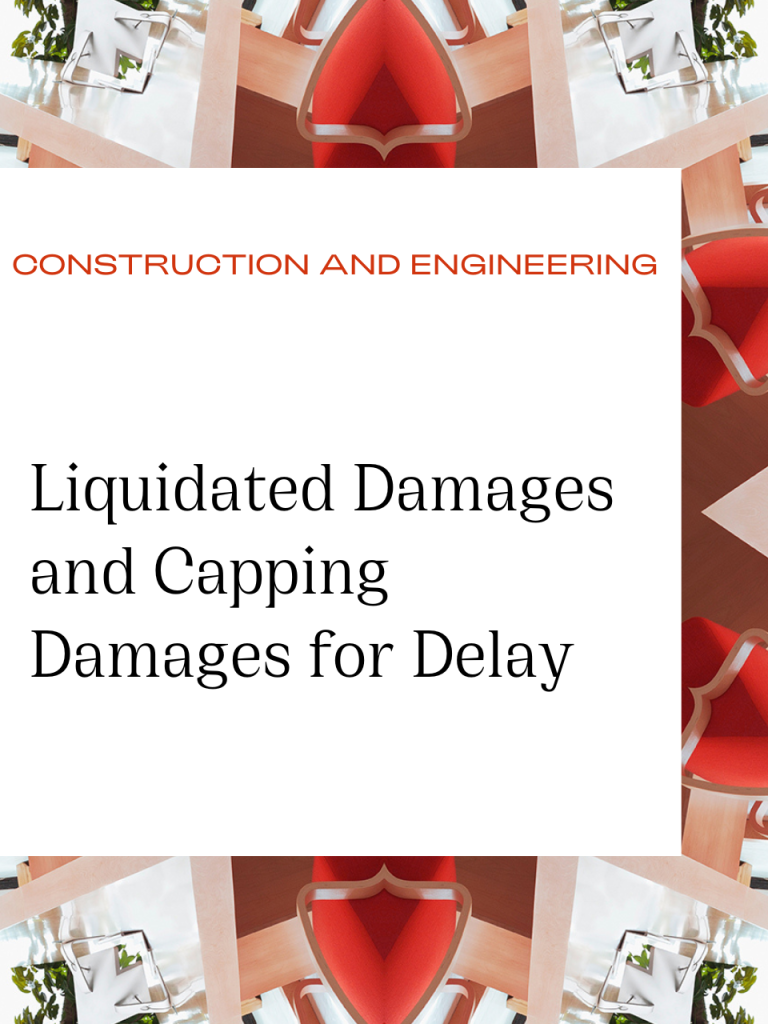LDs are generally considered to benefit both parties – the Contractor gains certainty as to their financial exposure in the event of delays, and the Employer is relieved of the burden of proving and quantifying their loss.
In order for LD provisions to be enforceable, however, it is essential that they are clearly drafted and that the quantum of damage is appropriate. This has been the topic of various cases in the UK and Ireland, with an interesting recent UK development.
Liquidated Damages Provisions Void for Uncertainty
In the September 2021 issue, we considered the UK judgment of Eco World – Ballymore Embassy Gardens Co Ltd v Dobler UK Ltd, which looked at whether a LDs clause was void and unenforceable because it did not provide for any reduction in the level of damages where the Employer had taken over some of the works.
To briefly recap the facts, Eco World had engaged Dobler under an amended JCT Construction Management Trade Contract (2011 edition) to carry out facade and glazing works on three residential blocks. The works had not been completed by the contractual completion date of 30 April 2018. On 15 June 2018 Eco World took over two blocks and the entirety of the works were later certified as practically complete in December 2018.
The contract provided for a single date for completion and for LDs of £0 for the first four weeks and, thereafter, of £25,000 per week, up to a cap of 7% of the final contract sum. Two main issues came before the Technology and Construction Court.
First, whether the LD clause was void and/or unenforceable. On this issue, the Technology and Construction Court (“TCC”) found it was not automatically fatal to have one rate of LDs where there was sectional completion or partial possession.
Secondly, the TCC considered whether, if the Court had considered the LDs provisions to be unenforceable (which it did not), any general damages recoverable by Eco World would also have been capped by reference to the 7% cap in the LDs provisions. In this instance, the Court considered that they would, stating that “a literal reading of the provision suggests that the 7% cap would apply only to the liquidated damages and not to any general damages. However, the clear intention of the parties was that Dobler’s liability for delay damages would be so limited.” Importantly, however, the TCC made clear that this would not necessarily always be the case and will depend on the specific contractual terms negotiated and agreed between the parties.
The Latest Developments
More recently the TCC has again considered the question of enforceability of LDs in the case of Buckingham Group Contracting Ltd v Peel L&P Investments and Property Ltd.
To briefly summarise the facts: Buckingham Group were contracted by Peel L&P, to construct a new plant at Ellesmere Port in Merseyside pursuant to a contract dated 29 January 2018. The contract was based on the JCT Design and Build Contract 2016 with various bespoke amendments specific to the project, including a regime for the payment of liquidated damages for delay (Schedule 10).
A schedule to the Contract set out dates for completion of certain milestones including for Practical Completion. The schedule also specified weekly amounts for delays to each milestone along with an overall cap on liquidated damages.
The works were delayed resulting in Peel L&P claiming liquidated damages from Buckingham Group.
Issues Before the TCC
Buckingham Group claimed that the liquidated damages regime was uncertain therefore making it void and unenforceable. Buckingham Group also argued that the cap on liquidated damages applied to limit any claim Peel L&P may make for general damages.
Buckingham Group argued that the liquidated damages regime was uncertain because:
(a) The contract schedule contained two columns with different LD amounts without indicating which was to apply;
(b) the date of “Practical Completion” differed from the “Date for Completion” found within the Contract Particulars; and
(c) the LD amounts in the schedule were calculated from a different figure to the final Contract Sum.
Certain and Enforceable
The Court acknowledged the high bar which exists for striking down contractual provisions on grounds of uncertainty.
Here, the schedule setting out the LDs came from a tender document which had been dropped into the Contract in an unedited form. It had to be considered in this context to ascertain the contractual intentions of the parties.
With regard to the conflicting completion dates, the court concluded that this was irrelevant as liability for liquidated damages arose for failure to meet milestone dates, and not for failure to meet the Date for Completion of the Works.
In relation to the discrepancies between the stated liquidated damages and the final Contract Sum, the Court held that the weekly sums in the table were what applied irrespective of the fact that, mathematically, they may have been computed by reference to an earlier proposal in respect of the Contract Sum.
The Cap on General Damages
Buckingham Group also argued, following the decision in Eco World v Dobler that, in the event that the liquidated damages regime was found to be void for uncertainty, the cap on liquidated damages also applied as a cap on general damages for delay.
In this Contract, the cap was expressed as the “Maximum LDs” and the Court found there was no rationale for reading this term more generally to cover general delay damages.
The Court also relied upon the fact that the cap was contained in a schedule to the Contract which dealt exclusively with liquidated damages, concluding that it applied only to the LDs.
Conclusions and Implications
Firstly, this case illustrates how appending correspondence or pre-contractual documentation to the final contract can lead to uncertainty, and parties should ensure that any such documentation is reviewed (and amended) prior to inclusion in the final contract.
Secondly, when deciding on the validity of the LDs schedule, the interpretation given by the TCC was motivated by the need to make the Contract work if at all possible. This often results in an inaccurate reflection of how the parties would have expressed themselves had the inserted Schedule been freshly drafted.
Interestingly, the TCC’s decision in relation to the cap on general damages does not follow the earlier Eco World v Dobler decision. The cap in that case was also in a section of the contract which dealt particularly with liquidated damages. It also expressed that LDs were to apply “up to an aggregate maximum of 7%”. We may now have some uncertainty, as there is no great difference in the facts of the two cases to account for the inconsistent conclusions reached by the Court in relation to the applicability of the cap to general damages where the liquidated damages provisions have been found to be void and unenforceable. This suggests that the question of applicability of an LDs cap to general damages is perhaps not as settled as may previously have been considered to be the case!
To read this article in PDF format, click here.
This article was originally published in the December 2022 issue of Irish Building Magazine and this is reproduced here with their permission.




